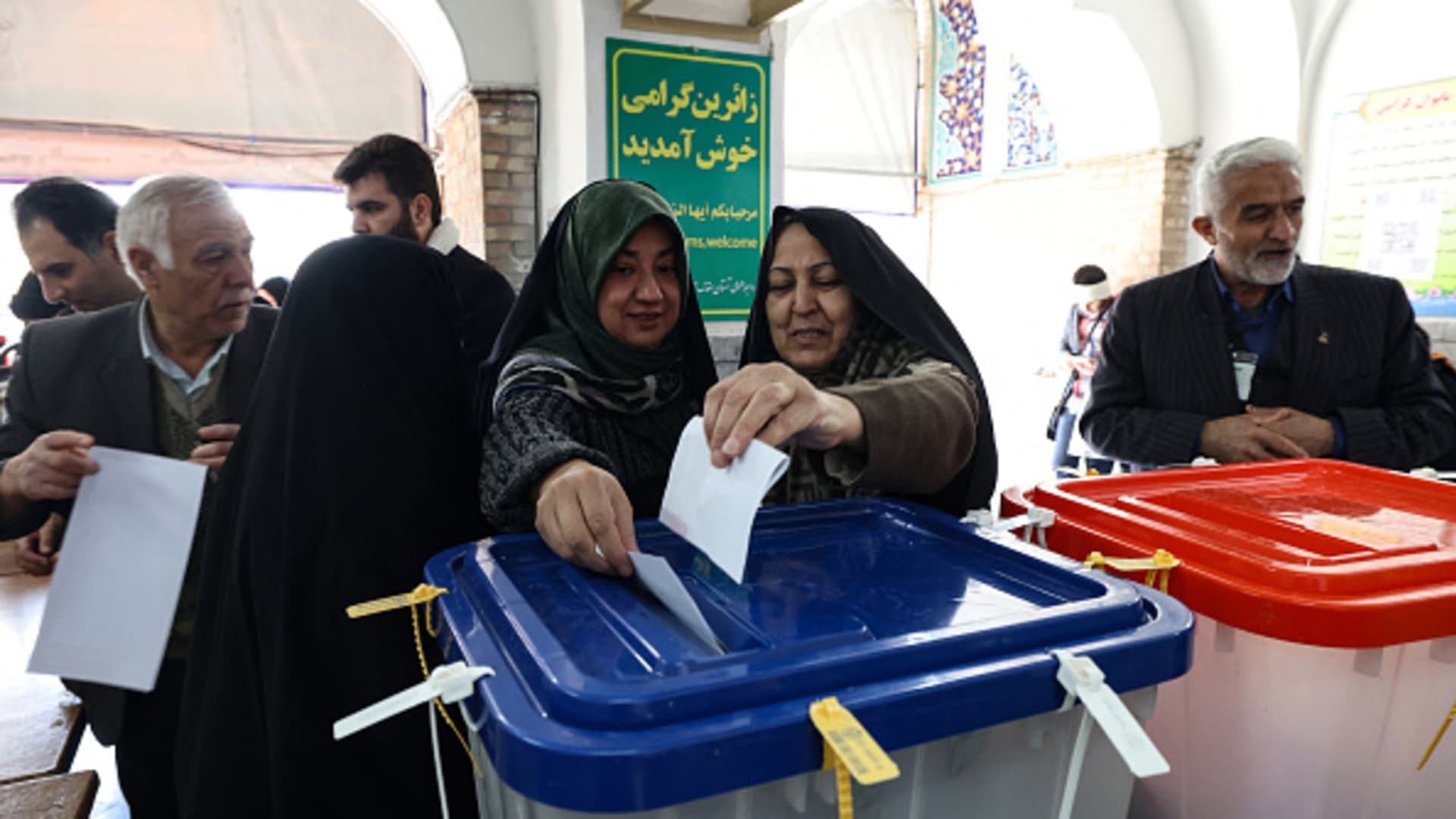Iranian women cast their ballots at a polling station during elections to select members of parliament and a key clerical body, in Tehran on March 1, 2024.
ATTA KENARE | AFP
Iran is voting for its next president Friday in a snap election following the unexpected death of former President Ebrahim Raisi in a helicopter crash — and the outcome could have implications far beyond its borders.
While there was no clear frontrunner leading up to the vote, all but one of the six candidates approved to run are conservative hardliners — and half of them have been sanctioned by Western governments. Of the six initial contenders, four remain in the race after two dropped out on Thursday.
If there is no clear majority after Friday’s vote, the top two candidates face a second round of voting on July 5. The winner will serve for four years — and faces no shortage of challenges.
The election comes at a fraught time for the country of 88 million, and turnout is expected to be low. Iranians will go to the polls against the backdrop of a battered economy, widespread popular discontent and harsh crackdowns on dissent. Iran is also dealing with high inflation, heavy Western sanctions, mounting tensions with the U.S., ramped-up Iranian nuclear enrichment and the Israel-Hamas war.
Voting is open to roughly 61 million eligible Iranians, but many have pledged to boycott, pointing out the lack of genuine choice for voters. Iran’s ultra-conservative Guardian Council controls who is allowed on the ballot and only approved six candidates to run for the presidency, out of a list of 80 registrants.

Most of the candidates are hardliners who hold staunch anti-Western positions, with just one representing the reformist camp. Women who had registered to run were all disqualified by the Council.
Iran’s last presidential and parliamentary elections in 2021 and March 2024, respectively, saw the lowest recorded voter turnout in the Islamic Republic’s history. Many observers expect that trend to continue.
“In the past, the government has put great emphasis on participation to claim popular legitimacy as a republic … the decline in turnout over the last several years underscores the public’s growing disillusionment with the system,” Iran analysts Ali Vaez and Naysan Rafat at the think tank Crisis Group wrote in a report.
“Many citizens have come to doubt that they can produce meaningful change through the ballot box,” they wrote. “A major reversal of that trend appears unlikely.”
Who is running?
Two candidates appear to be leading the race, according to national polls: Mohammad Bagher Qalibaf and Saeed Jalili, both staunch conservatives. The candidate field features only one reformist candidate, Masoud Pezeshkian. Two of the six initial contenders, Amirhossein Ghazizadeh Hashemi and Alireza Zakani, dropped out of the race on Thursday.
Mohammad Bagher Qalibaf: Iran’s current speaker of Parliament and a former Islamic Revolutionary Guard Corps (IRGC) commander, Qalibaf also previously served as mayor of Tehran and has already made three attempts at running for the presidency.
Saeed Jalili: A former nuclear negotiator, Jalili currently serves as a representative for supreme leader Ayatollah Ali Khamenei on the Supreme National Security Council, known to be the most hardline wing of the regime. Jalili is further on the right politically than Qalibaf and a longtime Iranian government insider, but has also had several failed attempts at running for office.
Masoud Pezeshkian: The sole reformist candidate in the field, Pezeshkian formerly served as minister of health and has been a parliament member since 2008. He is a member of the Islamic Consultative Assembly and the vice speaker of Parliament, and wants to loosen social restrictions like Iran’s strict hijab law and improve relations with the West, including potentially re-starting nuclear talks with world powers.
Mostafa Pourmohammadi: The only cleric in the race, Pourmohammadi formerly served as a prosecutor of the Revolutionary Court and deputy minister in Iran’s Ministry of Intelligence, working under both conservative and reformist presidencies.
Where the real power lies
Iran’s next president will have to contend with whoever takes the White House in November. This raises the stakes for both Tehran and Washington, as well as the Middle East writ large, as Iran comes closer than ever to nuclear bomb-production capability and continues to back proxy groups fighting Israel.
On issues of foreign policy and war, the Iranian president wields some influence and is the country’s public-facing messenger. But power and critical decision-making in Iran ultimately lies with the supreme leader, Ayatollah Khamenei, and unelected institutions like the Revolutionary Guards.
Iran’s Supreme Leader Ayatollah Ali Khamenei speaks with media after casting his ballot during the Iranian Parliamentary and Assembly of Experts elections at the Leadership office in Tehran, Iran, on March 1, 2024.
Photo by Morteza Nikoubazl | NurPhoto
“The paramount authority in the Iranian system is not the president but the Supreme Leader, whose sprawling office constitutes a shadow government that wields ultimate influence in key foreign and domestic policy decisions,” Crisis Group wrote.
“It checks the power of the presidency and the rest of the executive branch, which must also contend with the clout of elected and unelected state institutions, like parliament and the Revolutionary Guards.”
In this direction, observers are also closely watching the election for any indications regarding the succession plan for the ageing supreme leader, Ayatollah Khamenei. Khamenei has supported Russia in Ukraine, attacked Israel amid the Gaza war and armed proxy groups like Hamas in Gaza, Hezbollah in Lebanon and the Houthis in Yemen. Before his sudden death, Raisi was considered a top contender for the supreme leader’s succession.

